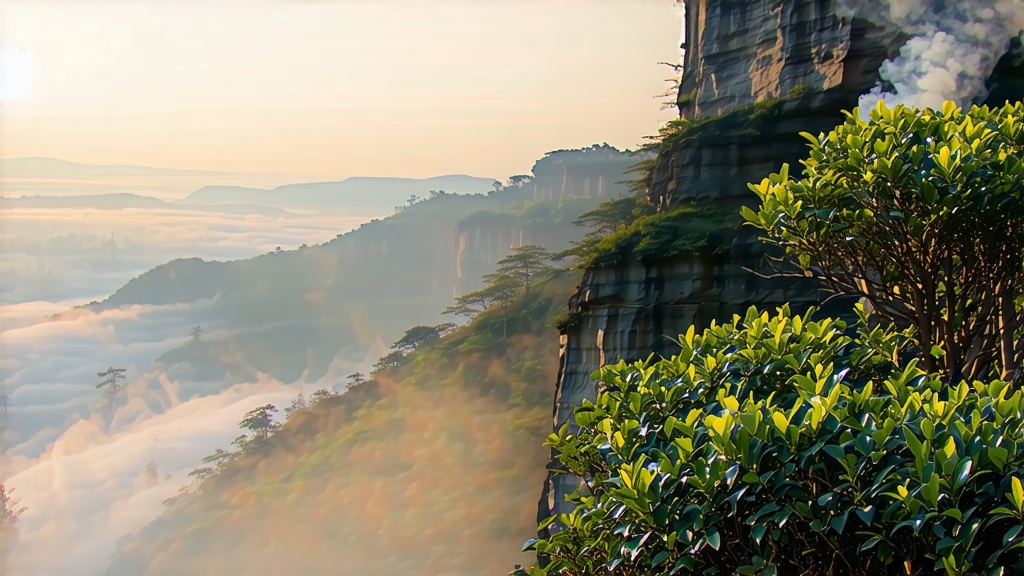
Long before Assam, Ceylon, or Earl Grey entered the global lexicon, the first fully oxidised leaf that Europe would christen “black tea” was born in the rugged Wuyi Mountains of northern Fujian. Locals simply called it zhengshan xiaozhong—“small-leaf from the original mountain.” Traders sailing out of Xiamen corrupted the place-name into “Bohea,” and the tea itself into “Lapsang Souchong,” a phonetic souvenir that still carries the aroma of pine smoke across four centuries.
The terroir is inseparable from the tale. Wuyi’s vertical gorges trap humid fog between cliffs of purple sandstone and weathered tuff. The soil is poor, forcing the tea bushes—varietals of Camellia sinensis var. sinensis with notably small leaves—to drive their roots deep, mining minerals that translate into a stony sweetness later revealed in the cup. Villages such as Tongmu, nested inside a national reserve at 1 200 m, remain the legally protected core of zhengshan (original-mountain) production; any leaf picked outside this 600 km² radius, even if processed identically, may only be sold as “wuyi black,” never as true Lapsang Souchong.
Two distinct styles now share the name. The traditional craft, often labelled “smoked” or “Pinewood Lapsang,” is still manufactured in Tongmu’s wooden guild houses. Fresh leaves are withered over slow-burning embers of local Masson pine; the resinous smoke drifts up through slatted bamboo trays, drying the leaf while impregnating it with volatile terpenes that later evoke campfire, resin, and dried longan. Once the leaf reaches 60 % moisture loss, it is rolled on rattan mats until the cell walls rupture, initiating oxidation that darkens the leaf from jade to umber within two hours. A brief second rolling follows, then firing again above hotter pine coals to arrest oxidation at 95 %, locking in the signature fragrance. Finally, the tea is rested for a month so that phenols and essential oils marry; only then is it judged ready for market.
Since the 1970s a newer, “unsmoked” or “craft” style has emerged to satisfy domestic palates that prize the honeyed minerality of Wuyi leaf without the campfire note. In this version, withering is done in heated rooms circulated with warm air, oxidation proceeds on bamboo baskets, and the final bake is a gentle charcoal heat reminiscent of cliff-oolong finishing. The result is a sleek, cocoa-brown strip that steeps into a burgundy liquor tasting of cacao nibs, candied peach, and a cooling menthol nuance that Chinese tasters describe as “mountain air.” Both styles, however, must pass the Tongmu Origin Audit: leaf morphology, pluck standard (one bud, two leaves, no laterals), and a minimum of 36 hours total processing time.
To brew either version gongfu-style, begin with 5 g of leaf in a 120 ml porcelain gaiwan. Rinse once with 95 °C water, discarding the flash infusion to awaken the leaf. Subsequent steeps last 10, 15, 25, 40, 60 and 90 seconds, using water just off a rolling boil. Observe the open leaves in the lid: smoked Lapsang unfurls to a leathery olive green, still bearing amber tar spots from the pine oils; unsmoked leaf shows a chocolate-brown center with russet edges, testimony to precise oxidation. The liquor should remain crystal clear; haze signals over-firing or adulteration with lesser Wuyi blacks. Aroma transitions across infusions: first steep delivers peak smoke or honey, second introduces dried apricot, third reveals a basaltic minerality, while later steeps fade into sweet potato and cooling sarsaparilla. A top-grade smoked Lapsang can yield eight infusions without collapsing into flat tannin; the unsmoked style often peaks at six, but finishes with a longer, orchid-like aftertaste.
Western-style brewing is forgiving, yet rewards attention. Use 2.5 g per 250 ml mug, 96 °C water, and a three-minute steep. Cover the mug to trap aromatics. Smoked Lapsang pairs surprisingly well with a slice of lemon